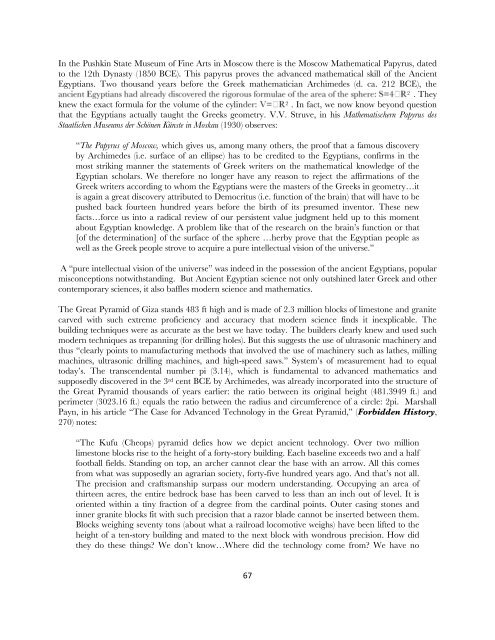Is THEM Guilty of Shirk? - Dr. Wesley Muhammad
Is THEM Guilty of Shirk? - Dr. Wesley Muhammad
Is THEM Guilty of Shirk? - Dr. Wesley Muhammad
Create successful ePaper yourself
Turn your PDF publications into a flip-book with our unique Google optimized e-Paper software.
In the Pushkin State Museum <strong>of</strong> Fine Arts in Moscow there is the Moscow Mathematical Papyrus, dated<br />
to the 12th Dynasty (1850 BCE). This papyrus proves the advanced mathematical skill <strong>of</strong> the Ancient<br />
Egyptians. Two thousand years before the Greek mathematician Archimedes (d. ca. 212 BCE), the<br />
2 . They<br />
knew the exact formula for the volume <strong>of</strong> the cylin<br />
67<br />
2 . In fact, we now know beyond question<br />
that the Egyptians actually taught the Greeks geometry. V.V. Struve, in his Mathematischern Papyrus des<br />
Staatlichen Museums der Schönen Künste in Moskau (1930) observes:<br />
―The Papyrus <strong>of</strong> Moscow, which gives us, among many others, the pro<strong>of</strong> that a famous discovery<br />
by Archimedes (i.e. surface <strong>of</strong> an ellipse) has to be credited to the Egyptians, confirms in the<br />
most striking manner the statements <strong>of</strong> Greek writers on the mathematical knowledge <strong>of</strong> the<br />
Egyptian scholars. We therefore no longer have any reason to reject the affirmations <strong>of</strong> the<br />
Greek writers according to whom the Egyptians were the masters <strong>of</strong> the Greeks in geometry…it<br />
is again a great discovery attributed to Democritus (i.e. function <strong>of</strong> the brain) that will have to be<br />
pushed back fourteen hundred years before the birth <strong>of</strong> its presumed inventor. These new<br />
facts…force us into a radical review <strong>of</strong> our persistent value judgment held up to this moment<br />
about Egyptian knowledge. A problem like that <strong>of</strong> the research on the brain‘s function or that<br />
[<strong>of</strong> the determination] <strong>of</strong> the surface <strong>of</strong> the sphere …herby prove that the Egyptian people as<br />
well as the Greek people strove to acquire a pure intellectual vision <strong>of</strong> the universe.‖<br />
A ―pure intellectual vision <strong>of</strong> the universe‖ was indeed in the possession <strong>of</strong> the ancient Egyptians, popular<br />
misconceptions notwithstanding. But Ancient Egyptian science not only outshined later Greek and other<br />
contemporary sciences, it also baffles modern science and mathematics.<br />
The Great Pyramid <strong>of</strong> Giza stands 483 ft high and is made <strong>of</strong> 2.3 million blocks <strong>of</strong> limestone and granite<br />
carved with such extreme pr<strong>of</strong>iciency and accuracy that modern science finds it inexplicable. The<br />
building techniques were as accurate as the best we have today. The builders clearly knew and used such<br />
modern techniques as trepanning (for drilling holes). But this suggests the use <strong>of</strong> ultrasonic machinery and<br />
thus ―clearly points to manufacturing methods that involved the use <strong>of</strong> machinery such as lathes, milling<br />
machines, ultrasonic drilling machines, and high-speed saws.‖ System‘s <strong>of</strong> measurement had to equal<br />
today‘s. The transcendental number pi (3.14), which is fundamental to advanced mathematics and<br />
supposedly discovered in the 3 rd cent BCE by Archimedes, was already incorporated into the structure <strong>of</strong><br />
the Great Pyramid thousands <strong>of</strong> years earlier: the ratio between its original height (481.3949 ft.) and<br />
perimeter (3023.16 ft.) equals the ratio between the radius and circumference <strong>of</strong> a circle: 2pi. Marshall<br />
Payn, in his article ―The Case for Advanced Technology in the Great Pyramid,‖ (Forbidden History,<br />
270) notes:<br />
―The Kufu (Cheops) pyramid defies how we depict ancient technology. Over two million<br />
limestone blocks rise to the height <strong>of</strong> a forty-story building. Each baseline exceeds two and a half<br />
football fields. Standing on top, an archer cannot clear the base with an arrow. All this comes<br />
from what was supposedly an agrarian society, forty-five hundred years ago. And that‘s not all.<br />
The precision and craftsmanship surpass our modern understanding. Occupying an area <strong>of</strong><br />
thirteen acres, the entire bedrock base has been carved to less than an inch out <strong>of</strong> level. It is<br />
oriented within a tiny fraction <strong>of</strong> a degree from the cardinal points. Outer casing stones and<br />
inner granite blocks fit with such precision that a razor blade cannot be inserted between them.<br />
Blocks weighing seventy tons (about what a railroad locomotive weighs) have been lifted to the<br />
height <strong>of</strong> a ten-story building and mated to the next block with wondrous precision. How did<br />
they do these things? We don‘t know…Where did the technology come from? We have no
















